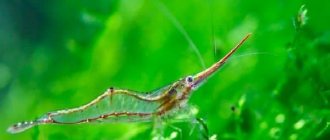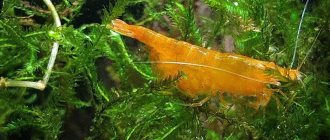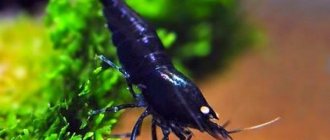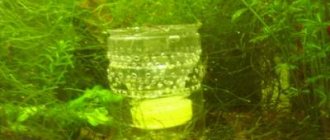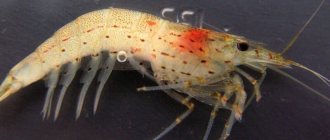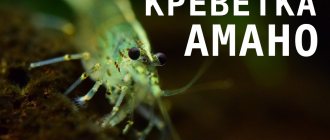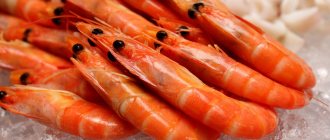Cherry shrimp (Red Cherry Shrimp, or Neocaridina heteropoda) is the most popular representative of crustaceans, widely used among aquarists. Cherry shrimp breed easily and survive even in the harshest aquariums, making them great for beginners. Having gained experience in keeping “cherries”, hobbyists move on to more demanding species - such as Amano shrimp or filter feeder.
Red Cherry Shrimp
What you need to know about cherry shrimp content:
- the minimum volume of the aquarium is 40 liters (although if there are few individuals, a tank of 10 liters or more will do);
- complexity of content – easy;
- food – omnivore;
- water temperature – 22-29°C;
- acidity pH – 6,5-8,0;
- water hardness kH – 3-10;
- life expectancy – 1-2 years.
Description and appearance
Cherry shrimp are highly valued not only for their high reproduction rate and unpretentiousness in maintenance, but also for the benefits they bring by eating algal fouling and food residues. Thanks to their bright red color, shrimp will liven up any aquarium, as they look great against the background of plants. They are also interesting to watch.
Cherry shrimp color can have different intensities
The body color of shrimp is usually cherry of varying intensities, but it is variable: pigment cells can instantly contract and expand, causing the cherry to instantly become very bright or fade. This depends on a number of factors, including nutrition, age, water parameters and vegetation around. On dark soil, shrimp darken, acquiring a more saturated color, and in case of stress (for example, if introduced into a new aquarium), they become almost colorless. Breeders have developed many color options, but more on that later.
Shrimp look best on black soil
Note ! Female shrimp are usually thicker, larger, and brighter-colored than males. But still, the main difference between females is the “saddle” on the back, the ovaries in the form of a yellowish spot, in which eggs develop.
Like all crustaceans, cherry shrimp molt as they grow and get rid of the old chitinous cover. If you see an empty shell in the aquarium, do not rush to remove it - it will still serve as food for the shrimp themselves.
Shed chitinous cover of cherry shrimp
How to distinguish a male from a female
It is easy to distinguish a male from a female. The female is one and a half times larger than the male and is painted in a darker, more saturated color. The lower abdomen of the female is slightly curved, which is not observed in males.
Females have a yellow saddle, but sometimes it is greenish. “Saddles” appear only in sexually mature individuals. Having seen it, you can expect the eggs to appear in the very near future. Cherry eggs are light yellow, but sometimes they are green. Differences in egg color do not affect the health of crustaceans.
Homeland, habitat
The homeland of Red Cherry Shrimp is Asian countries (Taiwan, Japan, Korea, China). Shrimp live in mountain rivers with medium or slow currents, bends and waterfalls. In addition, they like to settle in clean ponds and streams without excessive vegetation. At the bottom of such reservoirs there is usually a layer of fallen leaves, which reduces the acid-base balance and stops the development of bacterial/fungal infections.
Through the efforts of breeders, red cherries acquired a red color, which, unfortunately, can manifest itself in different ways from pale to fiery
Through careful selection and crossing of the brightest representatives, breeders from Germany managed in 2 years to develop a special bright red species, called cherry (cherry). In nature, these shrimp have almost no bright pigments. Only occasionally can you see several bright stripes on the shell.
On a note ! Now “cherries” have spread widely beyond their natural habitat. Due to their fertility and unpretentiousness to water quality, they easily displace local flora. And the reason is extremely simple - the unintentional spread of shrimp by irresponsible aquarists.
Yellow Fire Shrimp
Nutrition
Cherries are omnivores and will eat any food offered. The best choice is specialized dry food for crustaceans. Take granulated food for bottom fish species, crushed live food, flakes. They will not refuse pieces of vegetables, bananas, seaweed, lettuce, beech, oak, and hazel leaves.
Cherry shrimp food.
The main condition is not to overfeed. This is fraught with mass death of cherries; due to the decomposition of the remains of uneaten food, ammonia may be released. If you keep shrimp together with fish, you don’t have to feed them at all; leftover food will be enough for them. For Cherries living in a separate shrimp tank, it is better to feed them once a day; the food should be eaten within a maximum of 2 hours.
Popular types of Red Cherry shrimp
There are several varieties of cherries with significant differences in color. There are orange, brown, yellow and even black color options.
Table. Classes of cherry shrimp according to the color saturation of the shell.
| Name, photo | Short description |
| Red Cherry | This is the lowest grade of cherry shrimp. Transparent crustaceans with a certain number of red spots on their shell. Names: cherry, cherry. |
| Sakura | The sakura shrimp has a very rich red body color; occasionally there are spots without pigment on the shell. |
| Fire red | The main difference between the fiery red cherry is, as you might guess from the name, the bright red color of the body. |
| Bright fiery red cherry | The most valuable and expensive class. The shell of these crustaceans has a rich dark color (they even have red legs). There are no areas without pigment on the body. |
| Yellow | Yellow shrimp. It is also called the "canary". |
| Red crystal | A species developed through inbreeding. The peculiarity of crystals is weak immunity. |
| Harlequins | Dwarf shrimp with a red and white shell color. |
| Riley | This species is the result of a mutation. Riley shrimp come in a variety of colors. |
| Red Nose | A fairly large shrimp, the body size of which reaches 4 cm. |
As noted above, cherry shrimp can mimic decoration. To keep the color vibrant, use dark aquarium soil. Also, color to some extent depends on nutrition, and therefore it is better to give live and frozen food to crustaceans. Finally, there are drugs that enhance the color of the shell; they are added to the food.
Interesting facts, historical origin
- According to foreign sources, cherry shrimp was first discovered in Taiwan at the beginning of this century. In Russia, the first cherries appeared among aquarists in 2004.
- There is an opinion that cherries are capable of destroying dangerous algae (beards, threads). Not all experts support this point of view: the cherry tree can simply “trample down” this vegetation, as geese would do in the garden if they got to the beds.
- Copper is extremely dangerous for cherries. Pet stores have special conditioners that can remove copper from tap water, making it completely harmless to shrimp.
Keeping cherry shrimp in an aquarium
Shrimp are very hardy and prolific, and therefore even a beginner can cope with their maintenance. But we recommend keeping not just one individual, but a group of 5-10 crustaceans - this way the cherries will feel more comfortable.
Aquascape with cherry shrimp
Let's get acquainted with the basic conditions for keeping Red Cherry Shrimp in an aquarium.
- Shrimp can live at temperatures from +4°C to +30°. But note that when the temperature is too high, metabolic processes in the body accelerate, which is why the cherries quickly die. If the conditions in the aquarium are optimal, shrimp live up to 2 years. Despite their unpretentiousness, cherries do not tolerate sudden changes in temperature and other water parameters. Due to stress, activity may decrease and the brightness of color may be lost.
- The presence of nitrogen impurities and its compounds in water is undesirable.
- Shrimp reproduce very quickly; the size of the school can increase in a short time. They crowd out other crustaceans living in the same aquarium.
- Cherries are very sensitive to ammonia . To control its concentration, use special tests or, alternatively, install a larger aquarium.
- Shrimp are also very sensitive to copper contained in some fish preparations.
- Finally, if a large group of shrimp lives in the aquarium, then it is necessary to regularly remove their waste products. The problem is solved with the help of plants that partially recycle waste and a siphon for cleaning the bottom.
Cherry shrimp in thickets of Java moss
Please note ! It is advisable to use fine-grained soil (0.5-1.5 mm) in the aquarium. It is also important to take care of aeration and filtration. You can place a piece of driftwood in the tank and cover it with moss: the tree will serve as food for the newly hatched individuals, and the moss will serve as additional shelter.
Video - Cherry shrimp
Reviews
When an overpopulation of shrimp occurs in an aquarium, they jump out of the reservoir. This occurs in cases where approximately 100 or more individuals live in a 20-liter container. To control the population, I introduce fish that eat extra shrimp. If there are buyers for krill, or individuals with a particularly rich shell color appear, I move them into a separate container. Alexander, 33 years old, Samara
If you do not monitor the shrimp population, you may end up with shrimp without pigment in their shells. They fill the aquarium like cockroaches. From beautiful and colorful representatives of the cherry genus, shrimp turn into colorless creatures. I always select the most beautiful specimens from the young for posterity, and give the rest away, or take them to a pet store and drain them. Marina, 28 years old, Moscow region.
The aquarium is home to crustaceans, algae and fish, so I don’t worry about feeding the shrimp. They feed on fish scraps, algae, and waste. It's like a waste processing plant. You can sometimes sprinkle shrimp food. If everything is fine with the shrimp, they gather in a school. Hungry and dissatisfied people hide in secluded places. I watch the behavior of krill with interest. Even with regular feeding, I do one day a week as a fasting day. Alexey, 42, Astrakhan
Water parameters
Let's consider the optimal water parameters for an aquarium with cherry shrimp.
Table. Required water parameters.
| Volume per individual | Carbonate hardness | Comfortable temperature | Rigidity | Acidity |
| 1 l | 2-5 | +21-24°С | 6-8 | 7,5-7,8 |
As for plants that are suitable for shrimp, these include Java moss, Cladophora globulus, Riccia floating and Lomariopsis.
Riccia in the aquarium
On a note ! When a cherry tree is going through the molting period, it is especially defenseless and vulnerable. Small ceramic tubes placed on the bottom can be used as a shelter.
Out of the ordinary
Sometimes shrimp form a flock and get along well in an aquarium with other inhabitants. There are cases when crustaceans terrorize not only fish, but also large crayfish.
In order to scare away an overly curious fish, the shrimp can stand on its hind legs and defend itself with the help of antennae, or front fork legs. Also, krill can always escape.
Fire shrimp (sea shrimp) in a protective pose.
The fish for the shrimp tank are selected very carefully. To successfully keep and breed krill, certain conditions must be created. At the bottom of the aquarium there should be a large number of shelters where small crustaceans will feel safe.
Compatibility
Cherry shrimp are not aggressive towards other inhabitants of the aquarium. However, they are able to fight back against the offender. Often, if there are no suitable shelters in the aquarium, but there are fish that can swallow cherry tomatoes, the latter turn into live food.
Shrimp get along better with small fish
Clown fish, killi fish, neon fish, and gouramis are best suited for the role of neighbors. But if there are shrimp fry in the tank, then any fish will pose a danger to them. You can also keep tiger shrimp with cherry tomatoes. Typically, cherries can interbreed with some types of crustaceans.
The best way to feed
Some aquarists believe that when kept together with live plants and fish, there is no need to feed shrimp separately - the remainder of the fish food, algae fouling and detritus will be enough for them. This is true, but sometimes crustaceans need to be fed with special food to maintain the brightness of the color. Shrimp food is perfect for this, as well as fish food or catfish sinking tablets.
In the aquarium, shrimp accept crushed tubifex and live aulophorus well. So that active fish do not have time to eat all the food, you need to lower some of it into the thickets of moss and plants.
Diseases
Cherry shrimp are very disease resistant. But if your pet still gets sick, then most likely it will not be possible to cure it. Sometimes shrimp themselves do not get sick, but they carry various fish diseases. That is why it is recommended to keep valuable fish in a separate aquarium.
Red Cherry
Most often, shrimp suffer from parasites that occupy the shell, muscles, gills and heart. Often crustaceans die from fungal infections.
Note ! To avoid this type of problem, keep new specimens in quarantine for 7-14 days.
Reproduction
First of all, you need to learn how to determine the sex of adults. There is nothing complicated about it.
How to distinguish a female from a male?
Gender differences
Females, as noted at the beginning of the article, have a kind of “saddle”, a small light spot on the back of the head. Females are also distinguished by a massive body and have a larger abdominal cavity, since this is where the pockets for growing eggs are located. In adulthood, the male grows up to 2 cm, and the female - on average up to 3.5 cm. The male has a rather thin abdominal cavity, and he is also more active. It should also be remembered that females always have a more saturated color in their shell.
If the “saddle” has a green tint, it means that the female was bred from wild representatives. The yellower the “saddle”, the more cultured the shrimp’s genes.
Reproduction and breeding of cherry shrimp
Reproduction of cherry shrimp is a relatively simple process and does not require the creation of any special conditions. A short time after molting, the females are ready to mate and lay eggs.
Female cherry shrimp with caviar
Females ready for spawning release pheromones , which attracts males. After they have found each other, some semblance of a mating dance begins - the individuals wave all their paws and antennae opposite each other. Finally, the male wraps his limbs around the female, turns her over on her back and hangs a sperm package near the genital opening.
At the end of mating, the female stops releasing pheromones, and the males lose interest in them. Next, egg laying begins. Leaving the female's body, the eggs sequentially pass through the sperm packet left by the male and are fertilized. After this, the fertilized yellow eggs are fixed on the abdominal legs using special cords.
Note ! The female cherry shrimp is a very meticulous parent: she regularly cares for the eggs, cleans them of dirt particles, and removes unfertilized and spoiled eggs. Using the legs, a constant flow of water is created around the eggs to provide the eggs with oxygen.
Young cherry shrimp on a leaf in an aquarium
After 2-3 weeks, black eyes are found on the eggs. Formed small shrimps about 1 mm in size immediately appear from the eggs, which are very difficult to see in the aquarium, since they are usually hidden in the ground and are almost transparent.
On average, a female gives birth to 20-30 cubs per spawning. There is no need to feed newborn babies; they themselves feed on plankton and bacterial film. As you grow older, you can switch to specialized dry food.
Sex differences
Males are smaller and less colorful than females. In males, the tail is not adapted for carrying eggs, so it is narrower, while in females it is wider.
The easiest way to understand the male or female is when the female is carrying eggs; they are attached to the legs under her tail.
The female constantly moves and moves her legs so that there is an influx of oxygen to the eggs. At this time, she is especially timid and stays in dark places.
